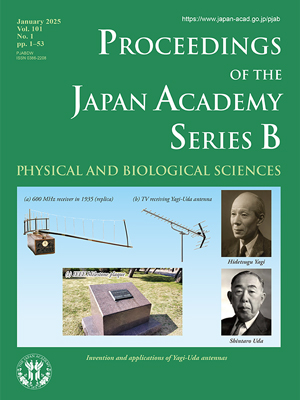About the Cover
Vol. 101 No. 1 (2025)
The paper by Chen in this issue (pp. 1–7) describes the events from when the invention of the Yagi–Uda antenna was first announced to when Yagi published their results in lectures in the United States and in his IRE (Institute of Radio Engineers) paper. These announcements have attracted European and American engineers. For example, a radar using this antenna was developed and used in the UK. The Japanese military is reported to discover this radar in 1942, and they were surprised to know that the antenna invented in Japan was being used in the radar of a foreign country.
Meanwhile, in Japan, Uda developed very high-frequency (VHF) band transceivers using vacuum tubes. In addition, he attempted to develop an ultrahigh-frequency (UHF) band wireless transceivers. At that time, medium waves had been put to practical use for radio broadcasting; however, radio waves at frequencies above the shortwave band were still in the research stage, whereas the use of VHF and UHF bands was pioneering. The VHF radio equipment using a Yagi–Uda antenna developed by Uda was put to practical use as a telephone system after communication experiments between Niigata City and Sado Island in Niigata Prefecture and between Sakata City and Tobishima Island in Yamagata Prefecture. In addition, in 1930, a long-distance communication experiment using 600 MHz UHF radio equipment with a Yagi–Uda antenna was successfully conducted over a distance of approximately 30 km between Sendai City and Otakamori in Miyagi Prefecture. At that time, this was the longest communication distance in the world for the UHF band. However, the Yagi–Uda antenna did not attract much attention in Japan after that.
The photo (a) shows a replica of a 600 MHz receiver and direction finder exhibited at the World’s Fair held in Brussels, Belgium, in 1935, which used a Yagi–Uda antenna (source: Research Institute of Electrical Communication, Tohoku University). Photo (b) shows a TV-receiving Yagi–Uda antenna (reprinted with permission from the website of Nippon Antenna Co., Ltd.). Photo (c) shows the IEEE (Institute of Electrical and Electronics Engineers) Milestone Plaque, which was dedicated by the IEEE in 1995.
Kunio Sawaya
Professor Emeritus, Tohoku University




